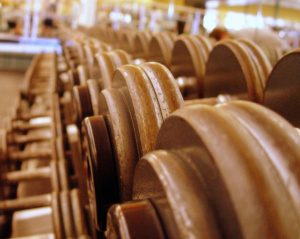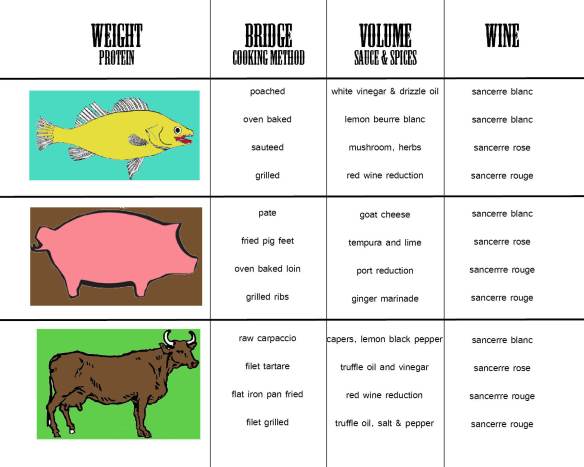Food and Wine Pairing: Weight, Bridge & Volume

A few weeks ago a good friend of mine, Aaron Epstein of Le Metro asked me to contribute to his newsletter with an approach to pairing food and wine. Le Metro is a new wine club for the hip and cool kids in wine. Aaron looks for wines that are hard to find and presents them in an underground newsletter, Le Metro. When he told me that his July newsletter was the “dark side of Sancerre” I was excited to jump in and help. The Le Metro newsletter is just down right cool! The design is chic yet urban. The wines are wines that I enjoy drinking. And the writing, well, a lot better than mine.
My task was to taste through the Sancerres presented in the newsletter and offer a food pairing for each wine. Aaron wanted it to be simple, straight to the point and visual. That was easy for me to do. I hate over complicating wine. We tasted two whites (Sauvignon blanc), two roses (Pinot Noir) and two reds (Pinot Noir). My approach to pairing these wines was based on Weight, Bridge and Volume.
Weight 
Weight is directly correlated to the weight of the protein and the body of the wine. Let’s take white fish filet, this is a protein of a light weight. When pairing a wine, you need to choose a light bodied wine, usually a white, such as Sancerre or Riesling. Reds with a lower alcohol have a lower weight, such as French Burgundy or Sancerre Rouge might also work with white fish (reds work with fish if the Bridge allows for it). A dish of a heavy weight would be red meat such as Ribeye or New York steak. These proteins demand a full-bodied wines, typically wines with a higher alcohol such as Cabernet Sauvignon or Syrah. Sancerre would just get lost, the weight of the protein is over powering, like walking on stilts made of crystal.
The Bridge 
The bridge is the connector. I usually refer to the cooking technique as the bridge. This element is what connects the protein to the right wine. A perfect example is going back to the white fish. The way a dish is prepared will bridge the dish to the wine. Using the fish example, a white fish baked in the oven would be more delicate than a fish grilled on a barbecue. The slow baked fish is light juicy and moist. The fish on the grill is drier and has grill marks which adds a bitter element which changes the wine you would pair. When pairing with Sancerre, the white Sancerre works better with the baked fish and a Sancerre rose would work better with the grilled fish. The rose has a bit more tannin which pairs with the bitterness of the grill marks. What was once a dish that normally paired with white wines has now been bridged to different wine just by changing the cooking technique.
Volume 
When pairing food and wine, it is important to look at the volume of the dish and the volume of the wine. What does that mean? Volume is intensity, the whisper or the scream. This concept is influenced by the weight and the bridge of the dish. For example, sea urchin is food with a low volume. It is delicate, the flavor is not intense and there is a whisper on your palate. On the contrary, my mom’s spicy enchiladas with sliced Habanero makes me scream! Those enchiladas are yelling, their volume is high. The volume of a dish is the sauce and spices. This dish is so spicy that the bridge is irrelevant, no matter how they are cooked (baked, pan-fried or microwaved) the volume is blaring that most wines are eliminated. Instead I reach for a refreshing Margarita.
Volume is determined by the acidity or the spiciness of the sauce. A very tart sauce will have a higher volume then a butter sauce. A filet seasoned with salt and pepper will have a lower volume than a filet blackened with Cajun spices.
When talking about the volume of a wine, we talk about alcohol, tannin and acidity, the basic structural elements of wine. Alcohol affects the weight of a wine. Usually, higher alcoholic wines have a full-body meaning they are heavier wines. If the wine is alcoholic and gives a burning sensation on the tip of your tongue, then we need to be careful with what we pair. A spicy dish will only raise the decibel levels of the wine. Have you ever had dinner in a restaurant blaring heavy metal? This is what pairing high alcohol and spicy foods feel like. Most importantly in food and wine pairing we need to look at the tannins and acidity. The tannins match with the cooking technique and the acidity can match the sauce. Although volume is related to the weight and the bridge, the sauce and spices will ultimately decide how loud the dish is.
Let say we serve filet of white fish with thinly sliced lemons in a light white wine sauce. The weight demands a light-bodied wine. The volume, the lemons and wine sauce demands a wine which matches those flavors. So a good pairing would be the Sancerre blanc which has citrus flavors, high acidity and light body. But if we changed the sauce and instead of the lemons and white wine sauce we serve it with sliced grapes in a Pinot Noir reduction. The Sancerre blanc will conflict with the red wine sauce. Serving the Sancerre rouge makes a better pairing. We have now adjusted the volume slightly enough so that a protein which normally calls for a white wine is served with a light red. Keep in mind that we still need to consider using a light-bodied wine with a lower alcohol level. The dishes volume was only adjusted ever so slightly. You can think of it as though we increased the bass and lowered the treble.
When we put the three concepts together this is what food and wine pairing looks like when related to Sancerre. Although it is not shown in the diagram, the best pairing for Sancerre blanc will always be shellfish such as oysters, mussels and clams in a light high acidic sauce or mignonette. Sancerre rose is great with goat cheese and charcuterie. Sancerre rouge makes a perfect paring with game birds with tart red fruit and red wine sauce.

If you are interested in joining Le Metro wine club, reach out to Aaron here. Cheers!








